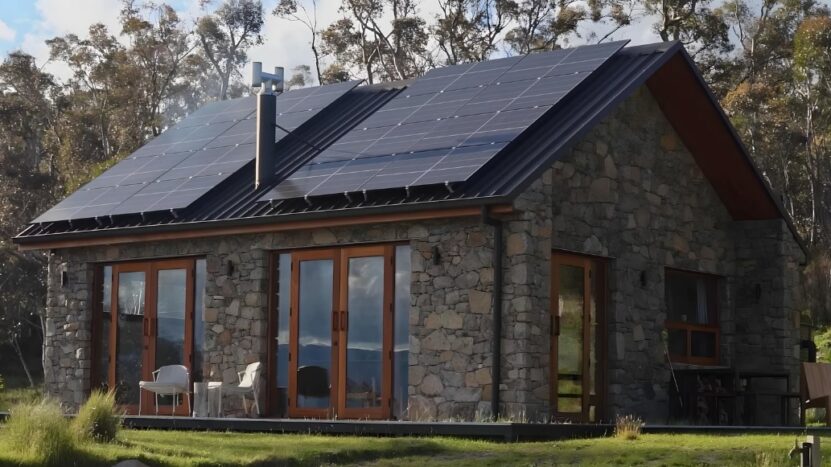Sustainable building materials are designed to minimize environmental impacts throughout their lifecycle—from extraction and manufacturing to usage and disposal.
These materials are often derived from renewable resources, recycled content, or innovative processes that reduce waste and energy consumption.
Let’s talk about some of the most eco-friendly ones.
Rammed Earth

Rammed earth is a time-tested construction technique that has gained modern attention for its sustainability and durability. When I was building my house, this choose this material, and I haven’t regreted it.
Rammed earth walls are known for their exceptional fire resistance, excellent insulation properties, and ability to absorb sound since they are composed of:
- Gravel
- Soil
- A small amount of cement
These qualities make rammed earth an ideal material for creating energy-efficient, comfortable living spaces.
Here are the major benefits:
| Benefit | Description |
|---|---|
| Longevity | Structures can last for centuries with proper maintenance, improving over time as the walls harden. |
| Pest Resistance | Naturally resistant to termites and other insects, reducing the need for chemical treatments. |
| Low Maintenance | Requires minimal upkeep, with occasional patching and protection from moisture being sufficient. |
| Environmental Impact | Utilizes local materials and has a low carbon footprint, contributing to sustainable construction. |
| Thermal Properties | Excellent insulation and temperature regulation, leading to energy-efficient buildings. |
| Aesthetic Appeal | Natural textures and colors provide a unique and attractive appearance. |
It is important to consider the environmental conditions where rammed earth will be used. In regions with high humidity or heavy rainfall, protective measures such as overhangs and proper drainage must be implemented to prevent water damage.
The construction process involves compacting layers of the earth mixture into forms to create solid, dense walls.
As a sustainable building material, rammed earth requires minimal processing, and local materials can often be used, reducing transportation emissions and overall environmental impact.
Recycled Steel

Recycled steel stands out as one of the most sustainable building materials available today, thanks to its impressive recyclability and strength.
Steel is the most recycled material globally, and the process of recycling steel maintains its inherent strength and durability.
By using recycled steel, significant energy savings can be achieved compared to producing new steel from raw materials.
The environmental benefits of recycled steel are substantial. The production of recycled steel uses less energy and emits fewer greenhouse gases than traditional steel manufacturing processes.
Utilizing recycled steel helps to divert waste from landfills and reduces the need for mining virgin materials, which can have detrimental environmental impacts.
Here are the benefits:
| Benefit | Description |
|---|---|
| Durability | Resistant to pests, fire, and extreme weather conditions, enhancing building longevity and safety. |
| Fire Resistance | Less likely to collapse in a fire, reducing potential loss and improving safety. |
| Weather Resilience | Withstands extreme weather conditions such as hurricanes, tornadoes, and earthquakes. |
| Strength-to-Weight Ratio | Allows for lighter structures without compromising stability, enabling innovative architectural designs. |
| Prefabrication | Can be prefabricated off-site, streamlining construction, reducing costs, and minimizing site disruption. |
| Precision and Consistency | Ensures high-quality construction with accurate and consistent components. |
Recycled steel is also versatile, finding applications in a wide range of construction elements, including beams, columns, roofing, and cladding.
Its adaptability to various building styles and its ease of assembly make it a preferred choice among architects and builders aiming for sustainability without sacrificing performance.
Bamboo

Bamboo is a remarkable building material that has gained popularity for its sustainability and impressive structural properties.
As one of the fastest-growing plants, bamboo can be harvested in a fraction of the time it takes for traditional hardwood trees to mature, making it a highly renewable resource.
But this is not the only benefit you can expect:
| Benefit | Description |
|---|---|
| Tensile Strength | Bamboo fibers run axially, providing higher tensile strength than steel. |
| Weight | Bamboo is light, making it easy to transport and install. |
| Elasticity | Bamboo’s elasticity allows it to withstand storms and earthquakes. |
| Fire Resistance | Naturally fire-resistant, can withstand temperatures up to 400°C. |
| Compressive Strength | Bamboo is sturdy, with even slender poles capable of bearing significant weight. |
| Safety | Easy and safe to work with, unlike more hazardous materials like asbestos. |
Bamboo’s versatility extends beyond structural uses. It is widely employed in interior design for flooring, paneling, and furniture, providing a warm and natural aesthetic.
The use of bamboo in these applications not only reduces reliance on traditional timber but also promotes a unique, eco-conscious style.
The cultivation requires minimal pesticides and fertilizers, and its extensive root system helps prevent soil erosion and promotes soil health.
Sheep’s Wool
Sheep’s wool is an exceptional natural insulation material that has been used for centuries due to its excellent thermal properties and sustainability.
It is harvested annually during the sheep’s natural shearing process, ensuring a continual supply without harming the animals.
It is easily the biggest benefit of this approach, but it is not the only one:
| Benefit | Description |
|---|---|
| Superior Insulating Capability | Wool fibers trap air, creating an effective barrier against heat loss in winter and heat gain in summer. |
| Moisture Absorption and Release | Absorbs and releases moisture without compromising insulation, regulating humidity levels and improving indoor air quality. |
| Biodegradability | Can be composted at the end of its life cycle, returning nutrients to the soil and minimizing environmental impact. |
| Fire Resistance | Inherently fire-resistant, does not emit toxic fumes when exposed to flames, enhancing home safety. |
The installation of sheep’s wool insulation is straightforward and does not require special equipment or protective gear, as wool is non-toxic and safe to handle.
It is commonly used in ceilings, walls, and attics to provide thermal and acoustic insulation, creating quieter and more comfortable living spaces.
Cork

Cork is a unique and highly sustainable building material derived from the bark of cork oak trees.
The harvesting process is environmentally friendly, as it involves stripping the bark without harming the tree, allowing it to regenerate over time.
Among the benefits of using cork in construction, here are the most important ones:
| Benefit | Description |
|---|---|
| Durability | Naturally moisture-resistant, prevents rotting or warping, ensuring longevity in humid areas. |
| Moisture Resistance | Ideal for flooring, wall panels, and insulation in damp environments like kitchens and bathrooms. |
| Acoustic Insulation | Excellent vibration-absorbing qualities, reduces noise levels within a home, suitable for soundproofing. |
| Elasticity and Compressibility | Withstands heavy foot traffic and furniture weight without permanent damage, suitable for high-traffic areas. |
| Thermal Insulation | Helps maintain comfortable indoor temperatures, contributing to energy efficiency. |
| Aesthetic Appeal | Natural texture and warm tones add distinctive look, can be stained or painted for design versatility. |
| Sustainability | Biodegradable and recyclable, promotes conservation of cork oak forests and supports local communities. |
The aesthetic appeal of cork is another advantage. It’s natural texture and warm tones add a distinctive look to interiors, complementing a variety of design styles.
Cork can also be stained or painted to match specific color schemes, providing versatility in its application.
In terms of sustainability, cork is biodegradable and recyclable, reducing its environmental footprint at the end of its life cycle.
The use of cork in construction not only promotes the conservation of cork oak forests but also supports the livelihoods of communities involved in its harvesting and processing.
Straw Bale

Straw bale construction is an ancient building technique that has experienced a resurgence in modern sustainable architecture.
Straw bales, made from the leftover stalks of cereal crops are a renewable and low-cost building material with excellent insulating properties.
We are talking mainly about the following crops:
- Wheat
- Rice
- Barley
Using straw bales in construction helps repurpose agricultural waste, reducing environmental impact and promoting a circular economy.
These are the main benefits of straw bale:
| Benefit | Description |
|---|---|
| High Insulating Capability | Dense, fibrous straw traps air, providing thermal resistance and maintaining comfortable indoor temperatures. |
| Energy Efficiency | Reduces need for artificial heating and cooling, leading to lower energy consumption and utility bills. |
| Sound Insulation | Thick walls offer excellent sound insulation, reducing external noise for quieter living spaces. |
| Renewability | Made from leftover cereal crop stalks, straw is a readily available and renewable resource. |
| Environmental Impact | Repurposes agricultural waste, reduces need for synthetic materials, and supports sustainable farming. |
| Simplicity of Construction | Can be built using basic tools and techniques, accessible to self-builders and community projects. |
| Breathability | Allows moisture to pass through, preventing mold and mildew buildup, maintaining healthy indoor air quality. |
Harvested annually, straw is readily available and does not require the destruction of forests or significant energy inputs for production.
When sealed with natural renderings, such as clay or lime plaster, straw bales become fire-resistant and durable, further enhancing their suitability for construction.
Building with straw bales is relatively straightforward and can be done using basic woodworking tools and techniques, making it accessible to self-builders and community projects.
Straw bales are typically used for constructing walls, providing structural integrity and insulation in one material. The dual functionality simplifies the building process and reduces the need for additional materials.








